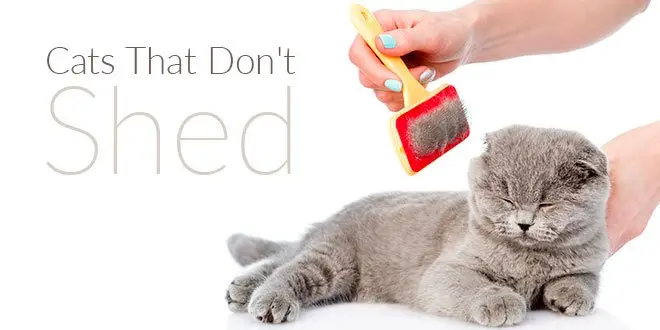[ads1] [dropcap]O[/dropcap]wning a cat comes with a lot of expenses, not the least of which is shedding control.
According to the American Pet Products Association, cat owners spent the same amount on grooming services and tools as they did on cat toys during a 12-month time frame.
That means that, for most owners, keeping cat hair off the floor and furniture was as essential as making sure their furry friends felt entertained.
One easy, cost-effective way to mitigate shedding in your household is to choose a cat breed that doesn’t shed to begin with.
Keep reading to find out more about cats that don’t shed.
Benefits of Cats That Don’t Shed
Before we get into our list of cats that don’t shed, let’s discuss some of the benefits of owning these low-maintenance felines.
Less Money Spent on Grooming
The American Pet Products Association found that pet owners spent $5.76 billion in 2016 on grooming and boarding services for their animals.
Cats that don’t shed cut down on those costs dramatically.
The great thing about non-shedding cats is their grooming routines are much less involved than that of their furrier compatriots. Many only require minimal brushing, which you can handle for free at home.
Less Time Spent on Cleaning
In addition to saving on their grooming budgets, owners of cats that don’t shed spend less time cleaning up after their feline friends. That’s less of your day spent vacuuming, sweeping, and de-shedding your furniture and more time spent enjoying your cat’s companionship.
Cats That Don’t Shed Offer Relief for Allergy Sufferers
Contrary to popular belief, cat fur isn’t usually what sets off feline allergies.
Most people who are allergic to cats are really reacting to Fel d 1, a sticky, lightweight protein found on cats’ skin and dander. Fel d 1 has a tendency to remain airborne, posing a constant problem for people with respiratory sensitivity.
While hypoallergenic cats still produce the Fel d 1 protein, a 2014 study found that they produce significantly less of it.
While cats that don’t shed won’t fully relieve strong cat allergies, hypoallergenic breeds can offer notable relief to allergy sufferers.
Our List of Cats That Don’t Shed
These breeds have the unique talent of not shedding their fur—or shedding so minimally it’s barely noticeable. Many of them are hypoallergenic, too.
[ads2]
Sphynx
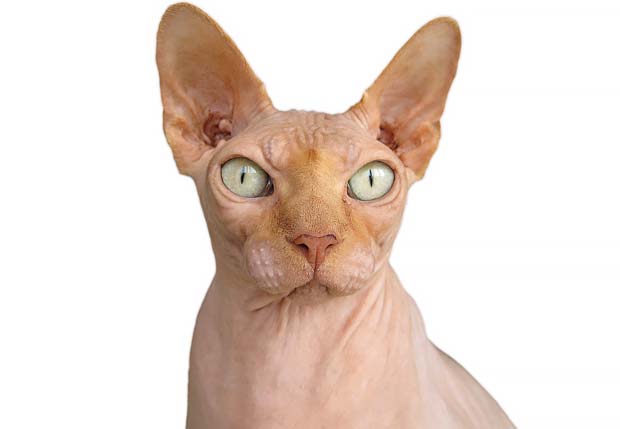
The Sphynx is really one of the most visually striking cats that don’t shed. Most people have a strong opinion of the breed—they either love their wrinkled, odd appearance or don’t.
Sphynxes are not actually as hairless as they appear. Instead, they have a fine layer of down that can come in a wide range of colors. That downy fluff gives their signature wrinkly skin a soft, peach-like texture.
Sphynxes also have characteristically large ears and wide-set eyes. They are medium-sized cats and are extremely active, curious, and friendly companions.
As you might guess, the Sphynx’s unique coat also makes it prone to cold. Many owners find their cats tend to curl up on warm computers, under the covers, or constantly on their laps.
While brushing is not necessary with this breed, the Sphynx’s lack of fur makes it prone to oil buildup. Regular baths are a must for this truly shed-free breed.
Cornish Rex
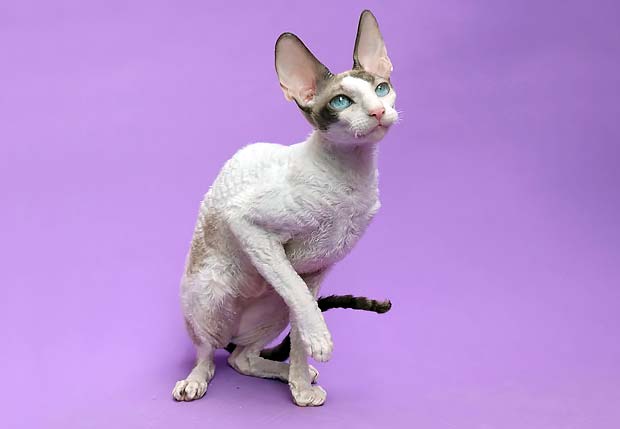
Many cat owners who like the idea of a Sphynx but not the hairless appearance turn instead to the Cornish Rex. Like the Sphynx, this breed has large ears and a small or medium build.
Their coat, however, differs significantly. The Cornish Rex has utterly striking, curly fur. Their coat is very short and incredibly soft. In fact, some owners compare their fur to velvet or lambswool.
The Cornish Rex is a particularly intelligent breed. They are energetic and playful and often use their long limbs as hands as they play with toys and interact with their family.
Their fur requires minimal grooming. Areas where their fur is the most sparse, like their ears and toes, may require special cleaning to keep them from feeling oily or greasy.
Havana Brown
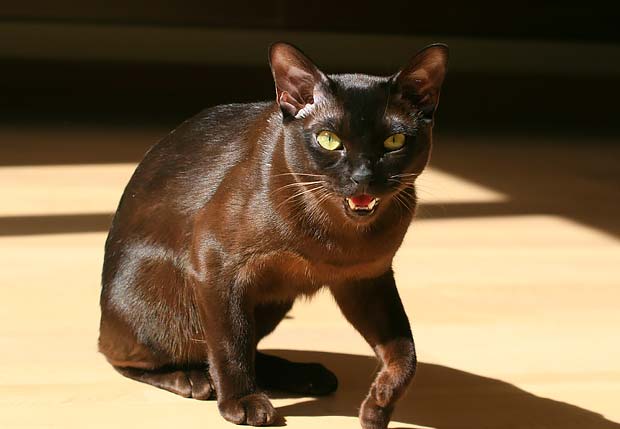
True to its name, this cat’s fur comes in a rich chocolate brown shade. Complete with striking green eyes, the Havana Brown is truly a beautiful cat.
The Havana Brown is a muscular, mid-sized cat. They are active and kitten-like and tend to retain their playful attitude well into adulthood.
They are very people-oriented and outgoing cats. They need to be an active, engaged member of your household. If they’re feeling a little neglected, they’ll find a way to let you know.
The Havana Brown’s short coat hardly sheds. A soft rubber brush is all you need to remove dead hairs.
Bengal
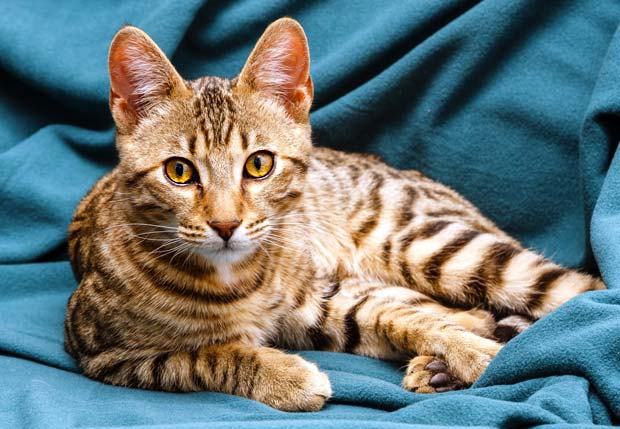
The Bengal is a truly unique, exotic-looking cat. Owing to their ancestry—which includes Asian Leopard Cat heritage—Bengals have retained the large size and spotted coat of their wild brethren.
Bengals are loving, highly intelligent, and incredibly athletic. They can be quite talkative, too.
This breed of cat likes to climb and stay busy. That’s why it’s essential to give their Bengals constructive things to do.
These cats make joyous, dynamic, affectionate companions. They tend to stay by their owners, curious as to what they’ll do next.
When it comes to fur, the Bengal’s spotted coat is exceptionally soft. Bengals shed their fur minimally, if at all. A quick wipe down is enough to keep this beautiful cat’s short, velvety coat healthy and lustrous.
Ocicat
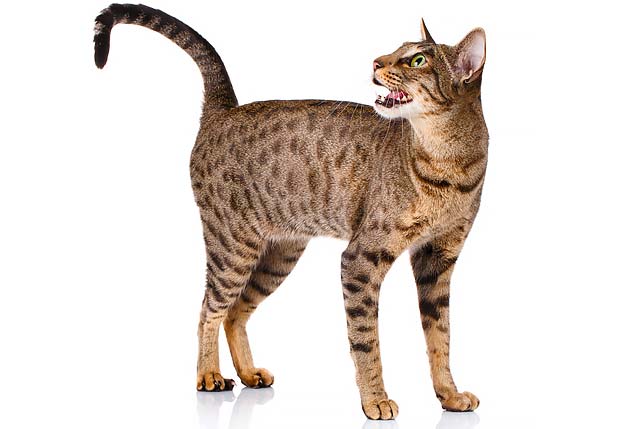
Like the Bengal, the Ocicat is a large breed. The Ocicat shares a similarly spotted coat with the Bengal, too—although this cat’s spots lack the jaguar-like rosettes of a Bengal.
While they share the name and appearance of the ocelot, the Ocicat does not share a real link with the South American jungle cat. Instead, the Ocicat was created in 1964 when a breeder crossed a red Abyssinian with a seal point Siamese.
That cross resulted in a striking spotted coat that comes in a range of brown, red, blue, or fawn varieties.
Ocicats are an active and muscular breed. They are highly devoted to their owners and make confident companions.
Their fur is short and satin-like. Simply use a rubber brush to remove any loose hair and your Ocicat is good to go.
LaPerm
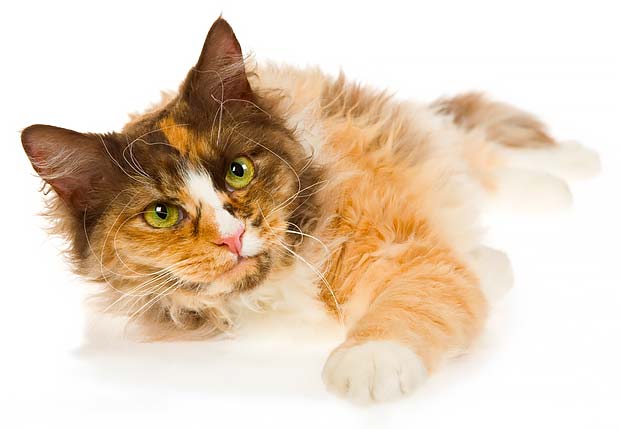
The LaPerm is a wonderfully exotic curly-coated breed of cat. While they can come in almost any color combination, their fur always shows a distinct wavy or rippled texture.
Derived from working barn cats, the LaPerm is a hardy breed. They are lean and muscular, as well as very active and outgoing.
They tend to be gentle and affectionate with their owners. They are highly people-oriented and do best owners who won’t stifle their curiosity.
A light brush with a comb is enough to maintain this cat’s unique coat. If you opt for a bath, don’t blow dry—you’ll dry out the LaPerm’s hair and cause frizz.
Cats That Don’t Shed—Much
While the following breeds aren’t as shed-free as the ones above, they still drop significantly less fur than other felines.
[ads2]
Bombay
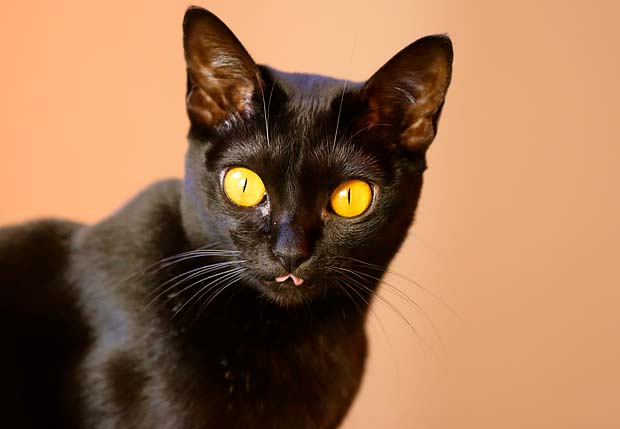
The Bombay is a sleek, jet-black breed with a friendly disposition. They have inquisitive, bright copper eyes that are sure to follow you wherever you go.
That’s because the Bombay is a true companion breed. They try to be as close as possible to their owners at all time. They’re very playful—sometimes even described as “dog-like.”
The Bombay’s shiny coat needs minimal upkeep. A light brush or wipe down with a chamois cloth is all you need to mitigate shedding for this miniature panther.
Siberian
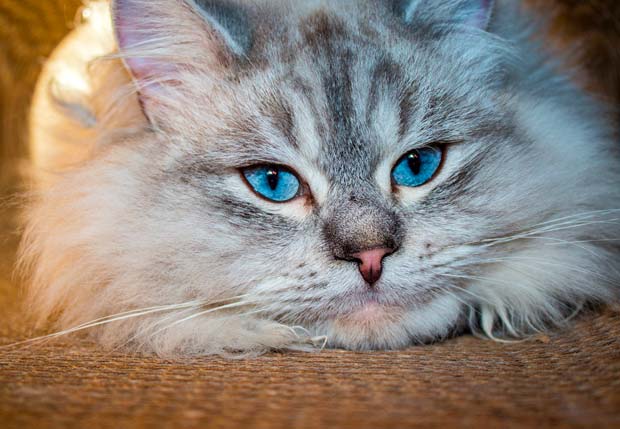
The Siberian is a majestic, powerful breed. They are large, muscular, and heavy-boned with large, lynx-like paws.
They are generally calm, quiet cats who exude a naturally confident fearlessness no matter the situation.
Unlike other cats that don’t shed, the Siberian has a bushy, triple-layer coat. That long fur comes in handy in this hardy breed’s Siberian homeland, insulating them from the cold and other extreme weather.
Despite this, they don’t shed as much as other furry breeds. They will need occasional combing to avoid mats and tangles, but their waterproof coat tends to care for itself.
One of the most compelling reasons to consider a Siberian, however, comes down to their skin. The Siberian is one of the most hypoallergenic breeds out there. They produce very little Fel d 1 protein, making them one of the best choices for people with allergies.
Russian Blue
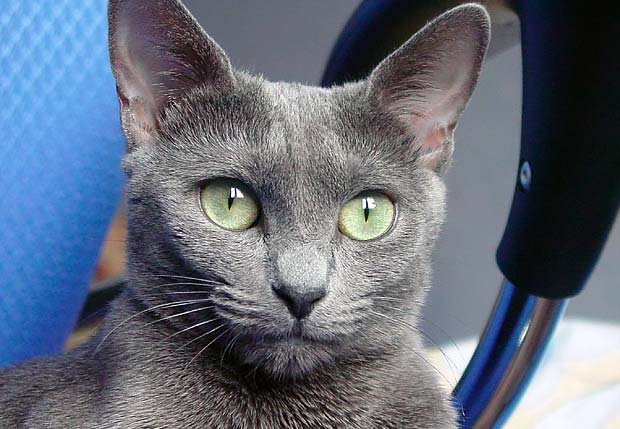
With their signature blue coats and bright green eyes, Russian Blues are an elegant choice for people looking for cats that don’t shed.
This distinctive breed tends to be a bit shy, but it has no lack of love and affection for its family. They are often described as intelligent observers, more likely to watch a situation from afar before getting involved.
They’re fast learners and enjoy a variety of interactive games. This independent breed is also adept at quietly entertaining itself.
The Russian Blue’s silvery-gray coat is short, plush, and dense. Most of their fur stays close to their medium-sized, muscular body. A quick brush down will take care of those that don’t.
[ads2]
Japanese Bobtail
The adaptable, friendly Japanese Bobtail is a great variety of low-shedding cat for families with children or other pets. With their signature bobtail and long, muscular back legs, they make a cute, athletic addition to any home.
Japanese Bobtails are smart, charming companions. They are excellent pouncers and jumpers and tend to talk to their families using soft meows and small “chirps.”
The Japanese Bobtail’s low-maintenance coat is usually mostly white with colored accents on the ears, face, and tail.
They lack an undercoat, which means they shed very little and require minimal brushing. The longest fur on their bodies is located on their tail, giving it a pom-pom-like appearance.
Turkish Angora
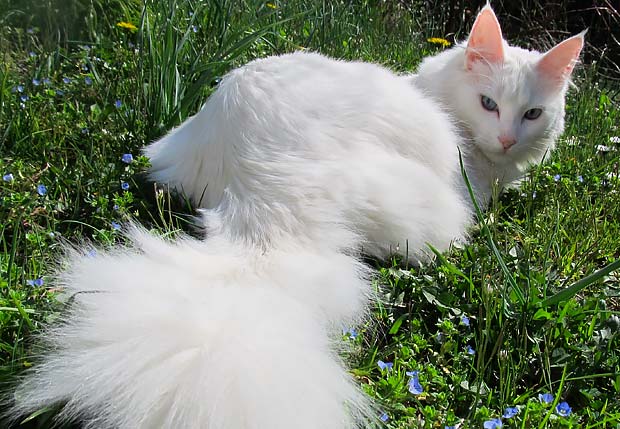
With the notable exception of the Siberian, most cats that don’t shed are short-haired—if they have hair at all. Not so with the beautiful, medium-haired Turkish Angora.
This slim, elegant breed is deceptively strong and athletic. Despite their fine-boned appearance, Turkish Angoras tend to act as leaders in their households, taking the alpha role over any other pets present.
These extremely intelligent cats are somewhat rare in the United States, but they are considered a national treasure in their homeland of Turkey.
Turkish Angora’s coats are of medium length and quite soft and silky. They have little to no undercoat and require very little grooming. A quick comb is all they need to keep their coats tangle-free.
Oriental
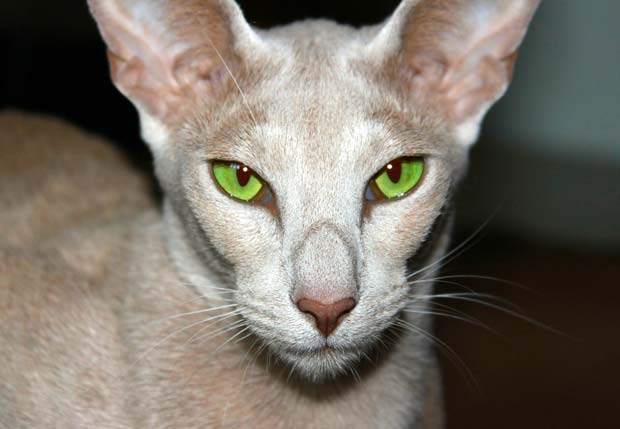
The Oriental is a curious, talkative breed of low-shedding cat. With their distinctively large ears and long noses, they make sleek, graceful companions.
Orientals become quite attached to their owners. Some choose a single person to follow, while others are content to interact with family members and visitors alike.
The Oriental coat comes in nearly every color possible. Their fur is very short and close to their lithe bodies, requiring only the occasional brush or wipe down to stay shed-free.
How to Care for Cats That Don’t Shed
While owners do spend much less time and money tending to cats that don’t shed, every feline still needs some regular upkeep to look their best.
Keep up with regular brushing or combing, especially for long-haired cats. Their fur won’t shed, but it can still tangle.
Wiping down your low-shedding cat with a chamois cloth or pet wipe can also add a lustrous sheen to their coat while grabbing any loose hairs that may be there.
If your cat is a fan of water—like Bengals and Turkish Angoras—give them regular baths with specially made cat shampoo.
If you’re interested in a Sphynx, you’ll need to take special care to ensure it remains bathed often.
As always, keep your cat’s nails trimmed, teeth cared for, and vaccination schedule up to date.
Find out More about Bengal Cats and Other Exotic Breeds
At BengalCats.co, we’re devoted to sharing information, photos, and videos of Bengal cats and other unique breeds. Visit our site to stay up-to-date on the latest Bengal news and to chat with other owners of the breed.

